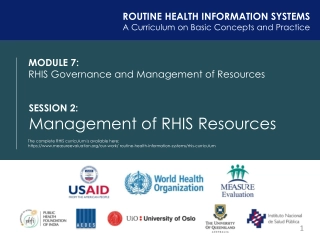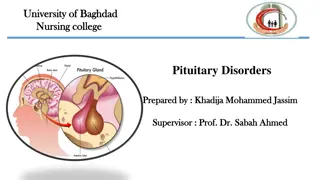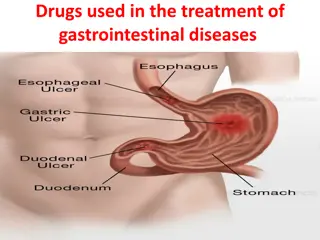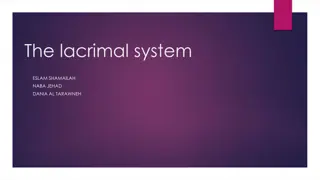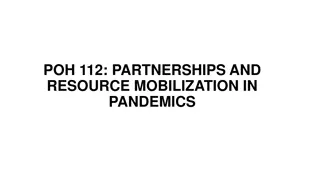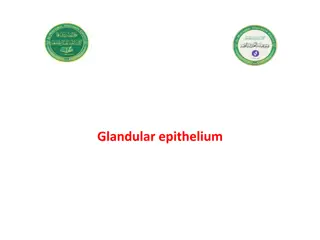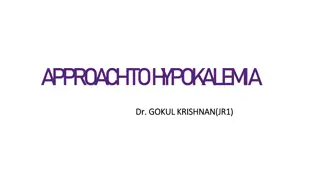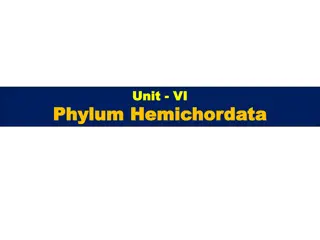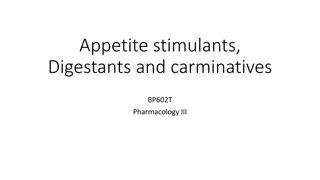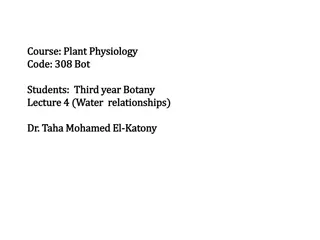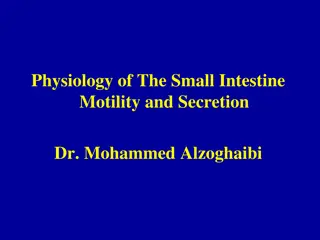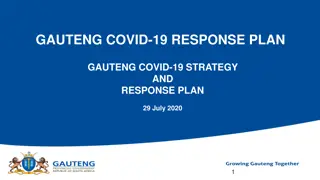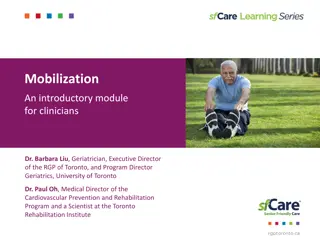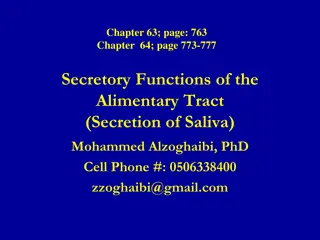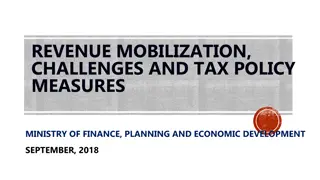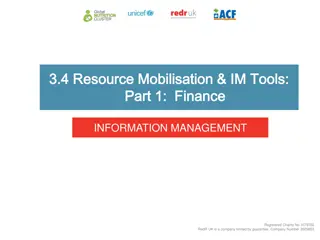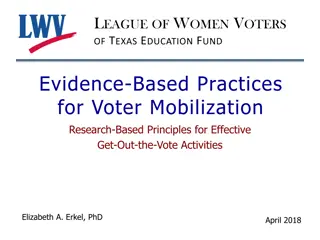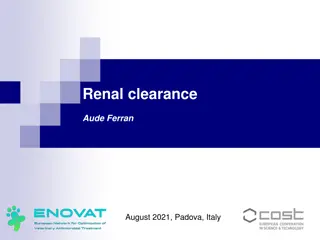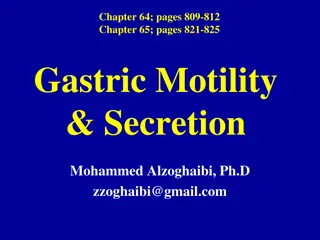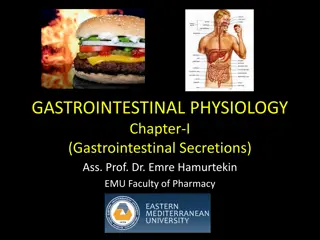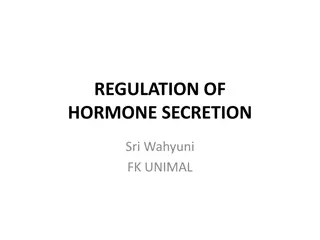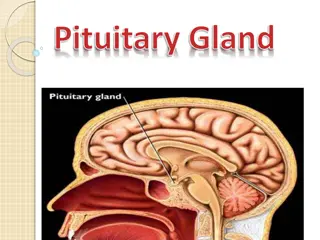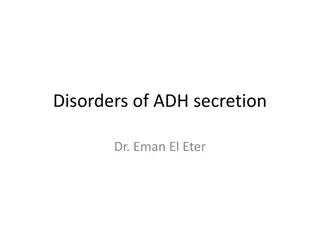Managing RHIS Resources: Governance and Mobilization
Governance and management of resources in routine health information systems (RHIS), covering topics such as human resources, financial resources, and physical resources. Participants will learn about workforce needs, training infrastructure, budgeting, procurement, and maintenance. The module also
1 views • 15 slides
Efficient Resource Mobilization and Management Strategies by Dr. Abraham Maliet Mamer
This content discusses efficient resource mobilization and management strategies, emphasizing the importance of understanding the typical cycle of resource regime, defining resources, identifying resources, and mobilizing resources effectively. It provides insights into resource allocation methodolo
2 views • 12 slides
Challenges and Opportunities for Reforms of Non-Oil Revenues Administration in South Sudan
The presentation highlights the reliance on oil revenues in South Sudan and the need for reforms in non-oil revenue administration. It discusses sources of non-oil revenue, factors hindering revenue mobilization, and opportunities for reforms to diversify the economy. The objectives of non-oil reven
3 views • 23 slides
Hyperparathyroidism
Hyperparathyroidism is characterized by overactive parathyroid glands leading to excessive secretion of parathyroid hormone and elevated blood calcium levels. This condition can cause symptoms like excessive urination, abdominal pain, weakness, and more. Primary hyperparathyroidism is often due to n
0 views • 20 slides
Pituitary Disorders
Pituitary disorders, often caused by tumors, can disrupt hormone production leading to various symptoms like weight gain, vision problems, and hormonal imbalances. The pituitary gland plays a crucial role in regulating bodily functions through hormone secretion. Factors such as tumor growth, head in
0 views • 25 slides
Peptic Ulcer Disease: Treatment Approaches and Helicobacter pylori Eradication
Common gastrointestinal conditions such as peptic ulcers can be effectively treated through approaches like eradicating H. pylori infection, reducing gastric acid secretion, and using mucosal protecting agents. Helicobacter pylori eradication is crucial for healing ulcers and preventing recurrence,
1 views • 27 slides
The lacrimal system
Disorders of the lacrimal system can lead to chronic symptoms affecting the eyes, causing discomfort and vision problems. Common abnormalities include dry eye, which can result from tear flow and evaporation issues. Aqueous-deficient dry eye, often associated with Sjögren's syndrome, is characteriz
3 views • 38 slides
Understanding Urinary Elimination: Anatomy, Physiology, and Function of the Kidneys
The lecture covers the fundamentals of urinary elimination focusing on the kidneys' location, structure, function, and the role of nephrons. It discusses the transport of urine through the ureters to the bladder, highlighting the bladder's muscle layers and the urethra's role in expelling urine. Stu
3 views • 37 slides
Understanding Renal Function Tests: Lecture Insights on Kidney Function and Structure
This lecture delves into the essential aspects of renal function tests, exploring the functional units of the kidney, the role of nephrons in maintaining homeostasis, and the intricate processes of filtration, reabsorption, and secretion within the renal tubules. Key topics include the hormonal and
4 views • 17 slides
Physiologie Digestive PHASE BUCCALE
Digestive physiology involves the breakdown of food into simple nutrients for absorption by the body. It includes mechanical and chemical means of food degradation using enzymes from salivary, gastric, pancreatic, and colonic bacteria. The digestive system comprises the mouth, esophagus, stomach, li
4 views • 25 slides
Comprehensive Overview of Pancreas Function and Structure
Pancreas is a vital organ in the abdomen with dual exocrine and endocrine functions. As an exocrine organ, it secretes digestive enzymes and bicarbonates into the duodenum for food breakdown. In its endocrine role, the pancreas regulates blood sugar levels by secreting insulin, glucagon, somatostati
1 views • 16 slides
Understanding Resource Mobilization for Pandemic Preparedness
This topic delves into partnerships and resource mobilization strategies essential for combating pandemics. Learners will gain knowledge on engaging partners, coordinating resources, and the importance of mobilizing different types of resources such as financial, technical, human, and institutional.
0 views • 18 slides
Understanding Glandular Specialized Epithelium and Glands
Glandular specialized epithelium forms a class of epithelial tissues with specific functions and structures, composed of cuboidal, columnar, and ciliated columnar epithelial cells. These tissues contain gland cells that are secretary in nature, with zymogen granules in the cytoplasm. Glands are spec
1 views • 35 slides
Understanding Glandular Epithelium and Secretory Cells
Glandular epithelium consists of epithelial cells specialized in producing and secreting various macromolecules, found in glands throughout the body. These secretory cells can synthesize proteins, lipids, and carbohydrates, with different types of glands such as exocrine and endocrine glands. The se
0 views • 13 slides
Understanding Hypokalemia and Potassium Regulation
Hypokalemia is a condition characterized by low potassium levels, crucial for intracellular functions. The Na+/K+ ATPase pump maintains the ICF/ECF gradient. Potassium excretion occurs mainly via the kidneys, with minimal variation in proximal tubule reabsorption. The collecting duct plays a vital r
2 views • 50 slides
External Morphology and Functions of Balanoglossus
Balanoglossus is an elongated, wormlike animal with a unique body structure divided into proboscis, collar, and trunk regions. The body wall consists of an outer epidermis, inner musculature, and peritoneum, providing protection and support. The proboscis is a club-shaped structure, the collar conta
0 views • 7 slides
Appetite Stimulants, Digestants, and Carminatives in Pharmacology III
Appetite is influenced by various factors including hypothalamic peptides, catecholaminergic pathways, and serotoninergic signaling. Loss of appetite, like anorexia, can stem from both physical and psychological causes. Alcohol can stimulate gastric secretion but chronic consumption may reduce appet
0 views • 8 slides
Understanding Water Relationships in Plant Physiology
Water plays a crucial role in the physiology of plants, with most absorbed water being translocated to leaves and lost through transpiration and guttation. While essential for turgidity and mineral translocation, plant water use is often inefficient. Transpiration is the primary mode of water loss,
3 views • 22 slides
Small Intestine Motility and Secretion Overview
The small intestine's motility and secretion processes involve various types of contractions and movements, such as segmentation contractions, peristalsis, and the migrating motor complex. These processes play a crucial role in mixing chyme, aiding in digestion, and facilitating absorption of nutrie
1 views • 43 slides
Gauteng COVID-19 Response Strategy Overview
Gauteng's comprehensive response plan to the COVID-19 pandemic includes a six-pillar strategy focusing on surveillance, contact tracing, healthcare system readiness, designated treatment hospitals, and social mobilization efforts. The Gauteng Department of Health is leading extensive measures encomp
0 views • 24 slides
Understanding Gastric Motility and Secretion in the Stomach
This content delves into the intricate workings of the stomach, focusing on its motor functions, anatomical and physiological divisions, gastric reservoir, storage and mixing functions, and relaxation reflexes. It emphasizes the key roles of the stomach in storing and preparing food for digestion, a
0 views • 47 slides
Mobilization: Importance, Risks, and Recommendations for Older Adults
Encouraging mobilization in older adults is crucial to counteract muscle loss and avoid negative health consequences associated with immobility. This module highlights the impacts of immobility, provides recommendations for mobilization based on frailty status, and offers ideas for promoting mobilit
0 views • 24 slides
Evidence-Based Practices for Effective Voter Mobilization
This tutorial provides research-based principles for effective voter mobilization, focusing on evidence-based practices for Get-Out-the-Vote (GOTV) activities. It covers dos and don'ts of voter mobilization, emphasizing the importance of connecting with voters, using gentle social pressure, and advo
0 views • 20 slides
Understanding the Secretory Functions of the Alimentary Tract
This content delves into the secretory functions of the alimentary tract, focusing on the secretion of saliva and the role of mastication. It covers the anatomy of salivary glands, composition of saliva, control of secretion by the nervous system, and the functions of saliva in lubrication, protecti
1 views • 30 slides
Uganda's Tax Policy and Revenue Mobilization: Challenges and Measures
The Ministry of Finance, Planning, and Economic Development in Uganda faces challenges in revenue mobilization and implementing tax policy measures. The tax policy aims to generate revenue for budget financing, promote investment and exports, redistribute income, and ensure compliance with regional
0 views • 22 slides
Humanitarian Resource Mobilisation and Information Management Tools
The content discusses the role of Information Management Officers (IMOs) and Cluster Coordinators in resource mobilization within humanitarian settings. It emphasizes the importance of tools such as financial tracking systems, capacity mapping, and checklists in informing the resource mobilization s
0 views • 13 slides
Evidence-Based Practices for Voter Mobilization by League of Women Voters of Texas Education Fund
This guide provides research-based principles and effective strategies for voter mobilization, aiming to enhance voter turnout through evidence-based practices. It covers dos and don'ts of voter mobilization, emphasizing the importance of connecting with voters on a personal level and focusing on th
0 views • 20 slides
Understanding the Secretions of the Gastrointestinal Tract (GIT)
The gastrointestinal tract (GIT) is responsible for digestion, absorption, and secretion through various glands along the alimentary canal. Secretions are stimulated by factors like direct contact, nervous system activation, and hormonal regulation. Hormones released in response to food presence hel
0 views • 7 slides
Understanding Renal Clearance and its Physiological Mechanisms
This content delves into the concept of renal clearance, exploring its relation to lipophilicity and mechanisms such as glomerular filtration, tubular secretion, and reabsorption. The processes occurring at the nephron level and the vascularization scheme are detailed, along with a breakdown of phys
0 views • 31 slides
Gastric Motility and Secretion in the Stomach: Functions and Division Overview
The stomach plays crucial roles in food storage, chyme preparation, water absorption, and slow emptying into the small intestine. Its motor functions include maintaining a reservoir, mixing food, and facilitating relaxation reflexes for optimal digestion. Anatomically and physiologically, the stomac
0 views • 46 slides
Overview of Gastrointestinal Secretions and Structural Considerations
In this informative presentation by Assistant Professor Dr. Emre Hamurtekin, the focus is on gastrointestinal secretions including salivary, gastric, pancreatic, biliary, and intestinal fluids. Structural considerations such as the surface area for absorption, sphincters, villi, and crypts are discu
0 views • 33 slides
Promoting HIV Prevention Services Among Female Sex Workers in Benue State Using Social Media Intervention
Female sex workers in Benue State, Nigeria faced challenges accessing HIV prevention services during COVID-19. To address this, a study utilized social media mobilization to reach and engage them, resulting in increased uptake of HIV testing services (HTS) compared to physical outreach. Through trai
0 views • 10 slides
Understanding the Regulation of Hormone Secretion and Feedback Mechanisms
Hormone secretion is tightly regulated to prevent overproduction or underproduction. It involves various factors such as nervous system signals, chemical changes in the blood, and feedback mechanisms. Hormones play a vital role in maintaining homeostasis by acting on target cells and eliciting speci
0 views • 17 slides
Understanding the Pituitary Gland: Structure, Function, and Hormones
The pituitary gland, located at the base of the brain, comprises two main portions - the anterior lobe (adenohypophysis) and the neurohypophysis. The anterior lobe consists of various cell types that secrete hormones like GH, prolactin, TSH, ACTH, FSH, and LH. GH, also known as STH, plays a crucial
0 views • 17 slides
State Veterans Commission Meeting and Mobilization Updates
State Veterans Commission held a meeting on June 2, 2017, discussing current and future unit mobilizations for FY17. The mobilization numbers by unit and month were provided, along with details on ARNG and ANG mobilizations. Additionally, the VISN 4 access data for outpatient appointments and trust
0 views • 33 slides
Challenges in Domestic Revenue Mobilization in Ethiopia
Challenges in domestic revenue mobilization in Ethiopia are attributed to poor tax revenue performance, driven by factors such as the economic structure, dominance of the informal sector, narrow tax base due to tax concessions, and limited tax policy and administration capacity. These challenges hav
0 views • 11 slides
Perspectives on Public Resource Mobilization and Aid in Africa
Perspectives on economic development in Africa in 2010, focusing on the mobilization of public resources and aid. The analysis delves into the importance of resource mobilization, taxation in Africa, and policy options. It also highlights the annual thematic focuses on structural issues such as priv
0 views • 17 slides
Economic Relations Division Overview and Achievements
The Economic Relations Division (ERD) is focused on sustainable socio-economic development through managing foreign assistance, implementing national strategies, and strengthening relationships with development partners. Key areas include external borrowing strategy, foreign assistance mobilization,
0 views • 22 slides
The Economics and Politics of Foreign Aid and Domestic Revenue Mobilization
This study explores the relationship between foreign aid, taxation, and domestic revenue mobilization, highlighting the impact of aid on tax/GDP ratios and the constraints faced in revenue systems. It discusses how aid influences policy choices, accountability, and bureaucratic costs, impacting reve
0 views • 25 slides
Understanding Disorders of ADH Secretion: Causes, Symptoms, and Treatments
Disorders of ADH secretion, such as Diabetes Insipidus and Syndrome of Inappropriate ADH Secretion (SIADH), present various manifestations like polyuria, polydipsia, and dehydration. Different types of Diabetes Insipidus have specific causes and treatments. Central DI results from pituitary gland da
0 views • 12 slides
